The Microsoft Surface Laptop 4 15-Inch Review: Refreshing Ryzen
by Brett Howse on May 6, 2021 8:00 AM ESTWireless
For years, Microsoft leveraged the Marvel AVASTAR wireless adapters, which were reasonable quick, but unreliable, and were really one of the most disappointing areas of any Surface device. Thankfully, they started to deviate away from Marvel last year, mostly thanks to the introduction of Wi-Fi 6, and Intel’s semi-integrated AX200 solution. But, on the previous generation AMD powered Surface Laptop 3, they instead chose a Qualcomm networking solution which was underwhelming, to say the least. The good news for 2021 and the Surface Laptop 4 is that Microsoft has righted this wrong and are now leveraging the Intel AX200 Wi-FI 6 solution even in the AMD powered Laptop 4.
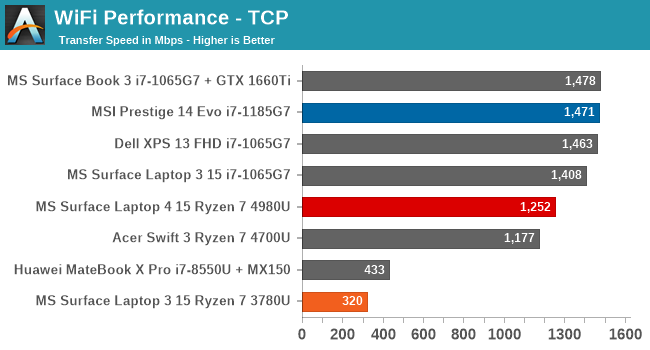
Performance is excellent. The Intel Ice Lake / Tiger Lake powered notebooks have the CVNi connected AX201, which does offer a slightly higher maximum transfer rates, but even the more traditional AX200 does very well over Wi-Fi 6. As is usual for Intel network adapters, reliability was top-notch.
Audio / Video
Microsoft offers Omnisonic speakers with Dolby Atmos support, and they conveniently locate the speakers underneath the keyboard. This faces the speakers towards the listener, and the result is surprisingly good.
Audio separation is quite good for a laptop computer, and while they lack the low-end performance of all notebooks, the speakers sound good in the mid and high ranges, and get plenty loud, with 84-85 dB(A) measured an inch over the trackpad.
On the camera front, the Surface Laptop 4 offers just a 720p webcam, although it does include Windows Hello IR support for fast logins. The laptop includes dual far-field microphones as well.
Thermals
Packing in eight cores, sixteen threads, and 8 CUs of Vega integrated graphics, the Surface Laptop 4 is the most powerful Renoir powered laptop in its class. The Ryzen 7 4980U offers the highest peak frequency, at 4.4 GHz, of the Renoir U lineup, which is the 15-Watt range.
Sadly, the performance monitoring tools we use were not able to poll the processor for power usage data, so we can’t get a proper feel on what kind of sustained power draw the laptop achieves, but Renoir has been quite power efficient, so it is likely in the 15-20 Watt range. We were able to poll sustained frequencies though. The Surface Laptop 4, under 100% load, quickly hit its 4.4 GHz peak, and then ran at a sustained 3 GHz for the rest of the run. There was no frequency degradation over time which would indicate the laptop was overheating.
Cooling was also very impressive. Despite the performance, Microsoft has been able to tune the fans to keep very quiet. Under most conditions, the fans are not even active, but under full load, the fans only registered 44 dB(A) even after over an hour of sustained load. That is very impressive.
Software
One of the most refreshing points in Surface ownership is that the Surface team does not install any extra software on the notebook. You don’t need to worry about browser plug-ins, antivirus trials, or the like. The only app that is installed is the Surface App, where you can get information about the device, and configure accessories such as the pen.
The Surface App works well, but it would be nice to see Microsoft give it some love. It has not really changed much in the last several years. Some additional functionality would be appreciated. It offers only the most basic functionality and support access.
One such feature that would be appreciated is the ability to set the maximum battery charge level. If you are a person that normally docks the device, being able to set the maximum battery level to something other than 100% can help prolong the life of the battery, and is functionality that other manufacturers do add. The Surface device offers two color profiles, with sRGB and Enhanced, and would it not be nice to be able to choose that in the Surface app, where the Surface app could explain what the settings do, rather than just a drop-down in the display settings with no explanation? It feels like there is a lot more than can be done here to enhance ownership. The Surface app is easy to use, it looks great, and it could use a bit more functionality.


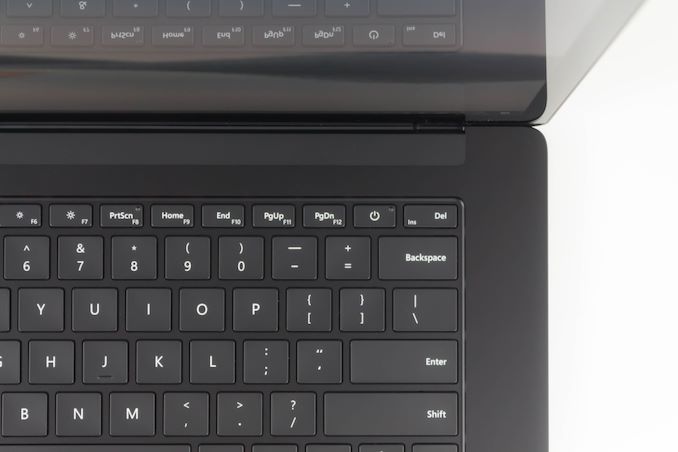

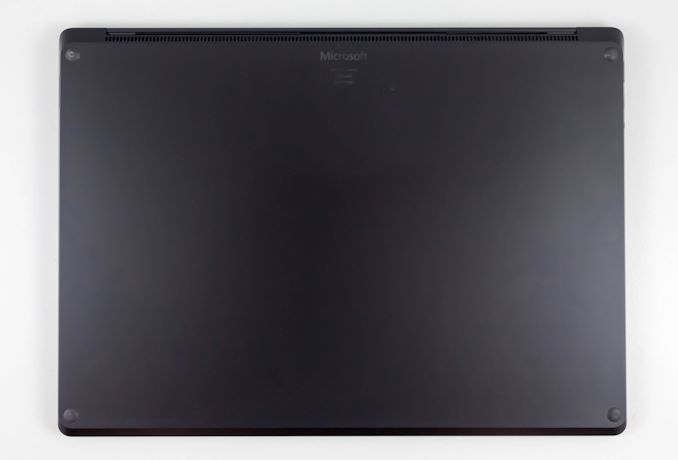
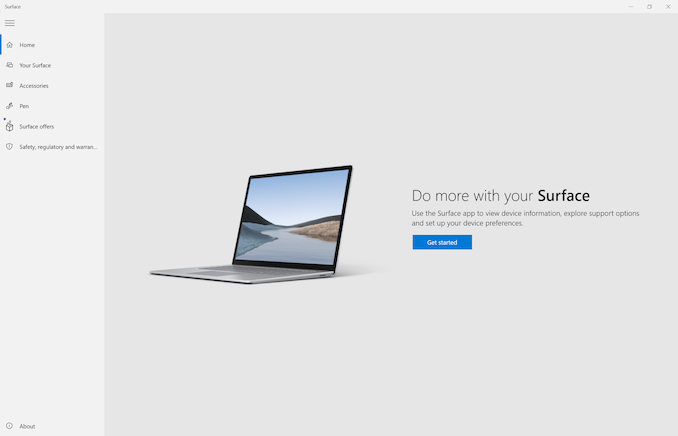
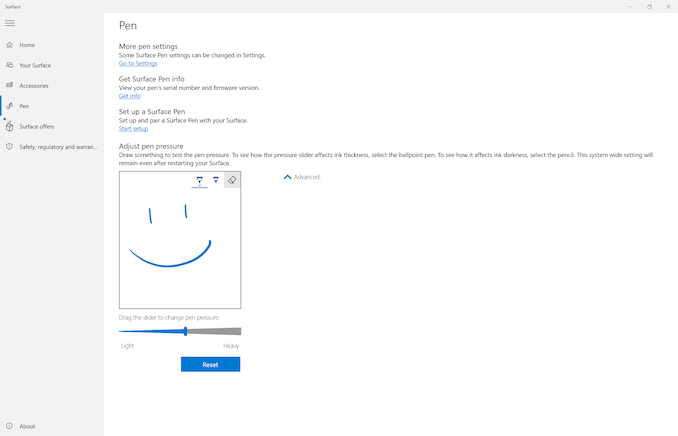








98 Comments
View All Comments
Reflex - Thursday, May 6, 2021 - link
This list is silly. Almost all of the things you mention are mostly accessed wirelessly these days. USB-A to USB-C adapters are super cheap and Anker sells a nice line of USB-C hubs that provide additional ports if you truly need them. I have one in my bag due to my Dell laptop having only 2 USB-C ports, but I can't even remember the last time I needed to use it.There are excellent actual bluetooth mice out there, I use a Microsoft one.
Who is using their optical drive on the go, or really at all?
Your storage is better in the cloud or on the network, again how most people use it nowadays.
Also, printers, can you even buy a decent printer that isn't wireless now?
And again, bluetooth keyboards are a thing and they are cheap.
Just bizarre list. Reads like someone stuck in computing from 15 years ago.
If this is your list of needs, modern ultrabooks are not for you.
Kevin G - Thursday, May 6, 2021 - link
Or people reasonably can't afford to repurchase everything. A cheap just to get it done wired mouse can be had for as little as $5 where as a good BlueTooth mouse starts at $20. The kicker is that people already have a wired mouse they could plug-in and use. Yeah, $20 in the grand scheme of things but when you have pay that extra amount five or six times, it starts to get noticed by the masses especially on top of the price of a new ultrabook.Ditto for printers. If you've saved up and purchased a unit years ago and is humming along nicely, why replace it with something new? At some point it does make sense to upgrade due to the lack of ink/toner available on the market or it just breaks down, but realistically things can last a very long time.
My Dell 5540M I'm currently using has two USB-A and one TB3 port and I often find myself limited. I use a lot of hardwired networking to isolated networks so there goes one port dedicated to that. The wired networking port generally gets the TB port even though it is type-A and I'll need an A-to-C adapter. One Type A goes to a wired mouse since it also doubles as a mouse for some systems that either have BT disabled or no wireless connectivity at all (and i'm not going to carry a second one if i don't have to). The remaining type A is often used for removable storage or a wired audio device. Thankfully I still have a dedicated barrel power jack. The TB3 port also supports power in a pinch and I borrowed other people's type-c chargers in an emergency. There are indeed times where I wish I had four USB ports.
I also do have access to a USB external optical drive which I pull out once or twice year to access an old physical media file. I've probably had this over half a decade with the same relative pace of usage and probably will keep on to it until it break at what point I imagine it'll pass the decade mark. My coworkers know I have it and again a few times a year one will ask to borrow it for a similar one-off data transfer. Migrating data to the network/cloud is a generally a good idea but it takes time, has costs (and monthly costs for the cloud) associated for it and a small amount of skill on the user's end.
simonpschmitt - Friday, May 7, 2021 - link
While your desccribed use case seems to need more (USB) ports at times most of it could be managed by a cheap USB-hub.Additionally, you must admit that this is beyond propably 99% of computer users out there.
Most people don't use one mouse for more than one computer.
Actually everyone I know outside IT does not use wired networking on a mobile device.
For my sisters (both teachers) and parents (small buisness owners) switching everything possible to wireless was propably the best quality of live upgrade since they use computers.
Kevin G - Monday, May 10, 2021 - link
Hubs can be problematic vs. having the port natively in a device. Large capacity hubs or those that can power other devices require AC outlets. Small data only hubs exist but generally are not the highest quality. Hubs also run the risk of some one tripping over a cable and unplugging everything off of that hub (uplink is disconnected) vs. a single device. A single home run to the host device is strongly preferred where every possible. This also applies to various adapters from say USB-C to DisplayPort: a single cable with the proper ends is preferred over a USB-C to female DP port and a DP-to-DP cable. Simply less to go wrong in the single path and you carry around less.Wired networking is critical for me as I often work on isolated, wired networks. There have been at times where I've been on two independent wired networks and still had wi-fi going. I realize that my use-case is rather specific but it does drive home the more general idea that the number of USB ports on a system is restrictively small, especially if they're pulling double duty for the likes of power, video, audio and networking.
PaulMack - Thursday, May 6, 2021 - link
I've had a Surface for some time and, while the limitation to one USB port is occasionally annoying, it's never been for a mouse. It's a premium device, and it's not unreasonable to spend $/£/€50 on a Bluetooth mouse. I only ever hit the limit when connecting a memory stick and another peripheral, and that's rare when on the move without the dock.MrCommunistGen - Thursday, May 6, 2021 - link
You can get a pretty inexpensive travel USB-A 3.0 hub for less than $20. I just keep one in my travel bag. A quick search turned up two different 4-port models for $13-15.yankeeDDL - Friday, May 7, 2021 - link
By "expensive adapter" you mean something like this (25usd)? https://www.amazon.com/-/es/Adaptador-USB-Hub-Mult...Using more than 2 USB port at the time is quite rare. Yes, more ports would help, but clearly teh space is rather limited.
Spunjji - Friday, May 7, 2021 - link
If you're using an external optical drive and a printer then you can probably handle using a hub, too.29a - Friday, May 7, 2021 - link
People giving presentations often need more than one USB port which I can see this laptop being used to give a lot of presentations. A flash drive and a Powerpoint presenter are both commonly used when giving presentations, that's two USB ports there.philehidiot - Sunday, May 9, 2021 - link
Typical use case for a business machine - running software that requires a USB dongle to operate. Removing it disables the software. One port down. Need to charge? Both down. How about people who leave a low profile USB drive in a slot for local back up purposes? If my livelihood is based on what is on that machine, I've got a local backup running as well as cloud.Sure, plug in a USB C dongle with a wire and giant block with all the connections you'll need (because having a different one for every use is expensive and fiddly) and you'd better not be using the laptop on your lap on a train or in a car. It'll dangle off your lap, yanking on the port constantly.
A business laptop, in my humble opinion, should have three available ports as a minimum. But as others have said here, they are likely working on feedback from telemetry and real world use. 95% of people don't use it so screw 5%.
In my view, a business laptop like this, with such an asking price should be putting in the extras that ensure more than the bare minimum for the majority. The people who have a use case as I have suggested above simply won't buy it, so it won't be their problem.